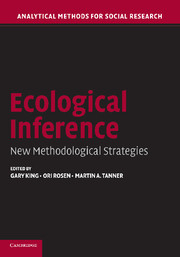Book contents
- Frontmatter
- Contents
- Contributors
- Preface
- INTRODUCTION
- PART ONE
- PART TWO
- 4 Extending King's Ecological Inference Model to Multiple Elections Using Markov Chain Monte Carlo
- 5 Ecological Regression and Ecological Inference
- 6 Using Prior Information to Aid Ecological Inference: A Bayesian Approach
- 7 An Information Theoretic Approach to Ecological Estimation and Inference
- 8 Ecological Panel Inference from Repeated Cross Sections
- PART THREE
- PART FOUR
- Index
4 - Extending King's Ecological Inference Model to Multiple Elections Using Markov Chain Monte Carlo
Published online by Cambridge University Press: 18 May 2010
- Frontmatter
- Contents
- Contributors
- Preface
- INTRODUCTION
- PART ONE
- PART TWO
- 4 Extending King's Ecological Inference Model to Multiple Elections Using Markov Chain Monte Carlo
- 5 Ecological Regression and Ecological Inference
- 6 Using Prior Information to Aid Ecological Inference: A Bayesian Approach
- 7 An Information Theoretic Approach to Ecological Estimation and Inference
- 8 Ecological Panel Inference from Repeated Cross Sections
- PART THREE
- PART FOUR
- Index
Summary
ABSTRACT
King's EI estimator has become a widely used procedure for tackling so-called ecological inference problems. The canonical ecological inference problem involves inferring the rate of voter turnout among two racial groups in a set of electoral precincts from observations on the racial composition and total voter turnout in each precinct. As a Bayesian hierarchical model, EI links information about the turnout by race in each precinct to information on turnout by race in other precincts through the assumption that turnout rates are independently drawn from a common distribution. In this way, strength is borrowed from other precincts in estimating the turnout rates by race within each precinct. Commonly, marginal turnout rates and racial compositions are observed for multiple elections within the same set of aggregate units. This chapter extends King's estimator to this case, allowing strength to be borrowed not only across precincts within the same election, but also across elections within precincts. The model is estimated via an MCMC algorithm, validated using simulated data, and applied to estimating voter turnout by race in Virginia during the 1980s.
INTRODUCTION
King's (1997) EI estimator has become a widely used procedure for tackling so-called ecological inference problems. The canonical ecological inference problem involves inferring the rate of voter turnout among two racial groups in a set of electoral precincts from observations on the racial composition and total voter turnout in each precinct.
- Type
- Chapter
- Information
- Ecological InferenceNew Methodological Strategies, pp. 97 - 122Publisher: Cambridge University PressPrint publication year: 2004

